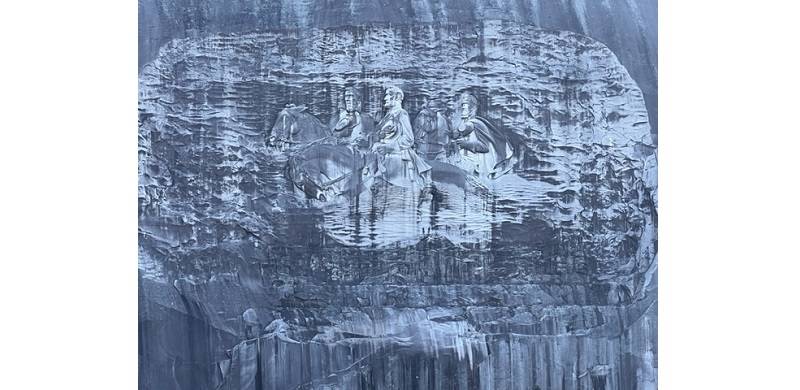
I saw the all-time epic Gone with the Wind in Karachi in the late 1960s. It glorified the way of life in the American South before the Civil War broke out in 1860. The rich lived comfortably in their palatial plantations. But they kept slaves, who had been captured in Africa, and treated them brutally.
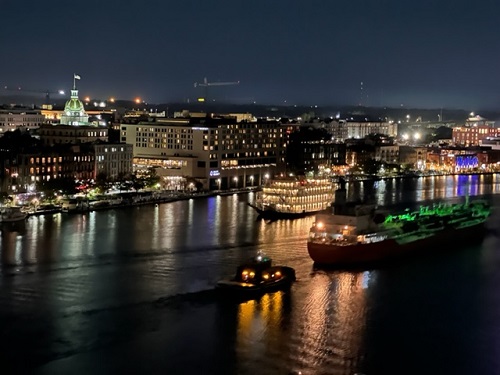 The movie brought to life the horrors of war. Death and devastation hung in the air. The movie showed in graphic detail the grief and pain that southerners suffered due to the war. It bemoaned the passing of a civilization, but I was left wondering as to what was there to bemoan in the death of a culture that was based on slavery.
The movie brought to life the horrors of war. Death and devastation hung in the air. The movie showed in graphic detail the grief and pain that southerners suffered due to the war. It bemoaned the passing of a civilization, but I was left wondering as to what was there to bemoan in the death of a culture that was based on slavery.
When I came to the US for higher studies in the 1970s, I began reading military history as a hobby. I learned that the strategies and tactics of the Civil War - which ended in 1865 - were widely studied in Europe for decades and the lessons from that war were applied by the generals who fought in WWI.
In the early 2000s, I climbed Stone Mountain in Atlanta. It is controversial because three leading figures of the Confederacy are etched on it: President Jefferson Davis and Generals Robert E. Lee and Thomas J. “Stonewall” Jackson.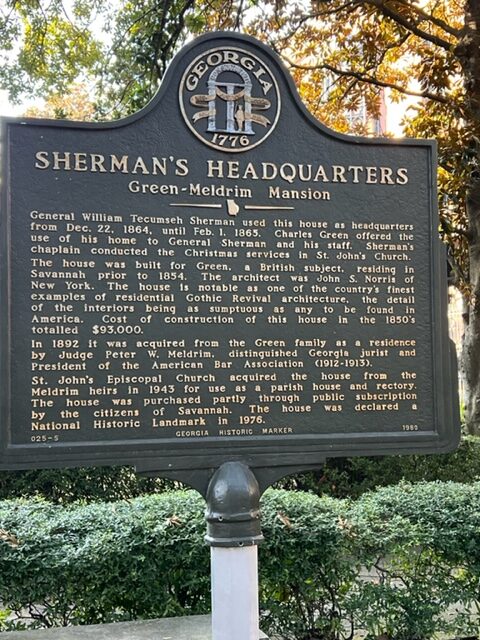
In 2019, while standing near the State Capitol building, I spotted a sign that commemorated Sherman’s March to the Sea from Atlanta to Savannah. I made a note to come back and retrace his route.
That opportunity presented itself a couple of weeks ago. We arrived in Atlanta and checked into our hotel. Our room on the 42nd floor gave us a clear view of downtown Atlanta. Not that far from us was the landmark Bank of America building, a few other high-rises and two churches.
This time we took the cable car to the top of Stone Mountain. Once we were on the top, we took in the sweeping 360-degree view. It was green everywhere, since Atlanta is essentially located in a forest.
I spotted a park ranger and asked him as to whose memory was being honoured in the Memorial Hall at the base of the mountain. He said it was the same figures whose images are carved on the mountain.
I said: “I understand the need to memorialise the heroes of the Confederacy, but showing them is just showing half of history. Where will I find a memorial to Sherman or Lincoln? After all, they saved the US from breaking up.”
A wry smile came on his face. With his hand pointing in one direction, he said, “You will find those in the North,” as if that was a separate country. I was going to ask him which side he was on, but just bit my lip. It was clear that even though a century-and-a-half has elapsed since the Civil War, the divisions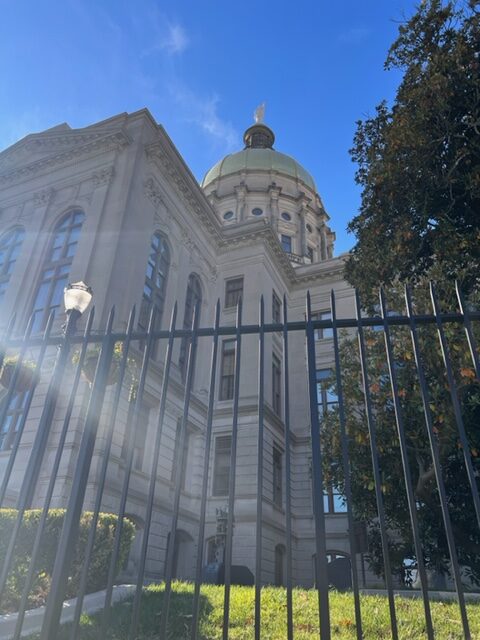 are still there.
are still there.
Afterwards, we went for dinner at Shalimar. We arrived early and it was almost empty. An hour later, it was packed. People of all ethnicities were savouring the best of Pakistani cooking.
Another day we visited the Jimmy Carter Center. Its museum and library evoked the JFK Center that we had seen in Boston, but its architecture was more subdued. Carter’s achievements during his presidency were only exceeded by his achievements as peacemaker and humanist after his presidency. In the documentary film that we saw at the start of the tour, Carter says that one of his top priorities when he was Georgia’s governor was to end racial discrimination. Among the many exhibits on display was a picture of his passport with a Pakistani visa stamped on it.
Later we visited the Atlanta Zoo. The flamingos from Chile and the big animals from the African savanna were fabulous, the snakes from the Amazon less so.
The Centennial Olympic Park was another noteworthy destination. A giant Ferris wheel was across the street. We felt the urge to revisit the joys of childhood and took a ride in it. Afterwards, we had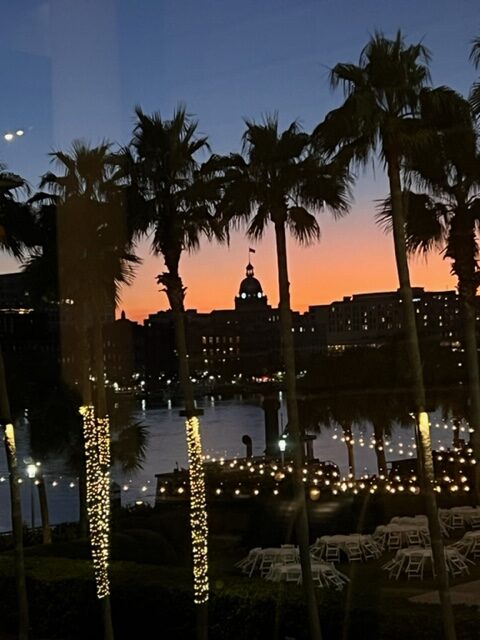 feasted on Grecian gyros at the CNN Center.
feasted on Grecian gyros at the CNN Center.
Then it was time to get on the Road to Savannah. Our driver had lived for 22 years in Atlanta. He had grown up in Ethiopia and was very well informed about world politics. We talked at fair length about current events in Ethiopia and Pakistan. He was quite well informed about the raid by the US Navy Seals that took out Osama bin Laden, but less well informed about General Zia’s plane crash.
During the four-hour drive, we did not see a single marker memorialising Sherman’s historic March to the Sea. Finally, we arrived in Savannah and checked into our hotel. It was located on the banks of the Savannah River.
From our room on the 15th floor, we could see the river. Savannah’s international port is the third busiest in the US, after Los Angeles and New York. We saw container ships coming and going several times during the day, often accompanied by tugboats.
Our hotel was located on a small island. Across the river lay the city of Savannah. Its skyline lit up at sunset and shone brightly at sunrise.
On our first day, we did a trolley tour and then a walking tour of the historic district. It is beautiful and appropriately renowned.
In the district is the house in which General Sherman had set up his headquarters. Savannah had surrendered without a fight and Sherman, so the story goes, gave the city as a Christmas gift to Lincoln.
There were no other monuments to see, so we toured two Victorian homes. They were as British a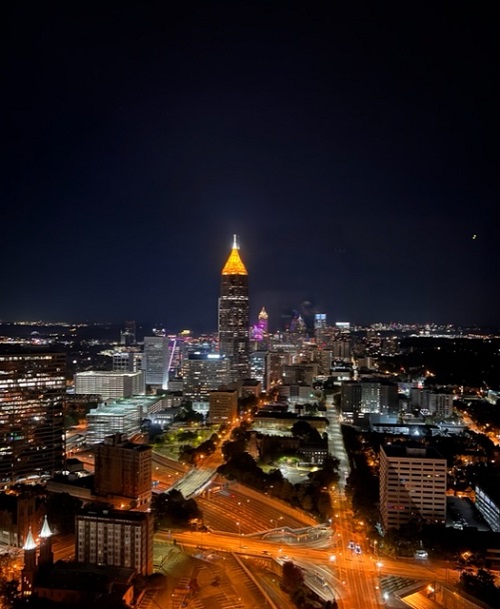 s any homes we had seen in England. Georgia was the 13th British colony in North America. It was named after King George II. British General Oglethorpe had established Savannah in 1733 and his name was everywhere.
s any homes we had seen in England. Georgia was the 13th British colony in North America. It was named after King George II. British General Oglethorpe had established Savannah in 1733 and his name was everywhere.
We joined a sightseeing cruise along the river on a four-decked vessel. It took us past a fort that dated back to the US war of independence. The cruise also gave us a glimpse of South Carolina, which lay across the river. We had toured the city of Charleston a few years ago.
Savannah is a haven for foodies. We had dinner one evening at a Persian restaurant called Persepolis. Another day we had English-style afternoon tea at Gryphon.
The week we spent in Georgia was very fulfilling. Even though we did not find much by way of the Civil War memorabilia that we had come to see, we did find much else – most notably, Southern hospitality.
 The movie brought to life the horrors of war. Death and devastation hung in the air. The movie showed in graphic detail the grief and pain that southerners suffered due to the war. It bemoaned the passing of a civilization, but I was left wondering as to what was there to bemoan in the death of a culture that was based on slavery.
The movie brought to life the horrors of war. Death and devastation hung in the air. The movie showed in graphic detail the grief and pain that southerners suffered due to the war. It bemoaned the passing of a civilization, but I was left wondering as to what was there to bemoan in the death of a culture that was based on slavery.When I came to the US for higher studies in the 1970s, I began reading military history as a hobby. I learned that the strategies and tactics of the Civil War - which ended in 1865 - were widely studied in Europe for decades and the lessons from that war were applied by the generals who fought in WWI.
In the early 2000s, I climbed Stone Mountain in Atlanta. It is controversial because three leading figures of the Confederacy are etched on it: President Jefferson Davis and Generals Robert E. Lee and Thomas J. “Stonewall” Jackson.

In 2019, while standing near the State Capitol building, I spotted a sign that commemorated Sherman’s March to the Sea from Atlanta to Savannah. I made a note to come back and retrace his route.
That opportunity presented itself a couple of weeks ago. We arrived in Atlanta and checked into our hotel. Our room on the 42nd floor gave us a clear view of downtown Atlanta. Not that far from us was the landmark Bank of America building, a few other high-rises and two churches.
This time we took the cable car to the top of Stone Mountain. Once we were on the top, we took in the sweeping 360-degree view. It was green everywhere, since Atlanta is essentially located in a forest.
I spotted a park ranger and asked him as to whose memory was being honoured in the Memorial Hall at the base of the mountain. He said it was the same figures whose images are carved on the mountain.
I said: “I understand the need to memorialise the heroes of the Confederacy, but showing them is just showing half of history. Where will I find a memorial to Sherman or Lincoln? After all, they saved the US from breaking up.”
A wry smile came on his face. With his hand pointing in one direction, he said, “You will find those in the North,” as if that was a separate country. I was going to ask him which side he was on, but just bit my lip. It was clear that even though a century-and-a-half has elapsed since the Civil War, the divisions
 are still there.
are still there.Afterwards, we went for dinner at Shalimar. We arrived early and it was almost empty. An hour later, it was packed. People of all ethnicities were savouring the best of Pakistani cooking.
Another day we visited the Jimmy Carter Center. Its museum and library evoked the JFK Center that we had seen in Boston, but its architecture was more subdued. Carter’s achievements during his presidency were only exceeded by his achievements as peacemaker and humanist after his presidency. In the documentary film that we saw at the start of the tour, Carter says that one of his top priorities when he was Georgia’s governor was to end racial discrimination. Among the many exhibits on display was a picture of his passport with a Pakistani visa stamped on it.
Later we visited the Atlanta Zoo. The flamingos from Chile and the big animals from the African savanna were fabulous, the snakes from the Amazon less so.
The Centennial Olympic Park was another noteworthy destination. A giant Ferris wheel was across the street. We felt the urge to revisit the joys of childhood and took a ride in it. Afterwards, we had
 feasted on Grecian gyros at the CNN Center.
feasted on Grecian gyros at the CNN Center.Then it was time to get on the Road to Savannah. Our driver had lived for 22 years in Atlanta. He had grown up in Ethiopia and was very well informed about world politics. We talked at fair length about current events in Ethiopia and Pakistan. He was quite well informed about the raid by the US Navy Seals that took out Osama bin Laden, but less well informed about General Zia’s plane crash.
During the four-hour drive, we did not see a single marker memorialising Sherman’s historic March to the Sea. Finally, we arrived in Savannah and checked into our hotel. It was located on the banks of the Savannah River.
From our room on the 15th floor, we could see the river. Savannah’s international port is the third busiest in the US, after Los Angeles and New York. We saw container ships coming and going several times during the day, often accompanied by tugboats.
Our hotel was located on a small island. Across the river lay the city of Savannah. Its skyline lit up at sunset and shone brightly at sunrise.
On our first day, we did a trolley tour and then a walking tour of the historic district. It is beautiful and appropriately renowned.
In the district is the house in which General Sherman had set up his headquarters. Savannah had surrendered without a fight and Sherman, so the story goes, gave the city as a Christmas gift to Lincoln.
There were no other monuments to see, so we toured two Victorian homes. They were as British a
 s any homes we had seen in England. Georgia was the 13th British colony in North America. It was named after King George II. British General Oglethorpe had established Savannah in 1733 and his name was everywhere.
s any homes we had seen in England. Georgia was the 13th British colony in North America. It was named after King George II. British General Oglethorpe had established Savannah in 1733 and his name was everywhere.We joined a sightseeing cruise along the river on a four-decked vessel. It took us past a fort that dated back to the US war of independence. The cruise also gave us a glimpse of South Carolina, which lay across the river. We had toured the city of Charleston a few years ago.
Savannah is a haven for foodies. We had dinner one evening at a Persian restaurant called Persepolis. Another day we had English-style afternoon tea at Gryphon.
The week we spent in Georgia was very fulfilling. Even though we did not find much by way of the Civil War memorabilia that we had come to see, we did find much else – most notably, Southern hospitality.

